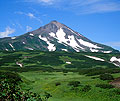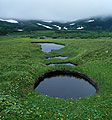1000-02
51°21' N, 156°45' E, summit elevation 1853 m
Koshelev volcano is a large west-east oriented range consisting
of at least five coalesced efifices (Fig.1). Most of the edifices were
formed in the Late Pleistocene time, and now host active hydrothermal
fields. Holocene activity of the volcano included two large events and
probably some minor eruptions.
The largest Holocene eruption was produced by the eastern cone of the volcano (Fig.2) about 6500 14C years BP. It started from voluminous ash-fall, which was dispersed at a distance of more than 50 km, and ended up with outpouring of lava flows on the northern slope of the volcano. Most interesting thing about this eruption is the composition of the erupted products. They all fall into the high-potassic field but the composition of fall deposits ranges from basalt-basaltic andesite to dacite, while lava flows are basaltic andesite. Fall unit includes grains of black porous basaltic andesite, dense and porous light-gray andesite, white dacite pumice and banded white-and- black varieties. Particles of different compositions occur in all the fall layers, from top to bottom of the fall unit, and no zoning is observed. Both cinder and pumice grains are present in this tephra far away from the source, that makes this layer a distinguishable marker. The eruption was accompanied by landslides and rock avalanches from the volcano's slopes. Cold mineral springs are located near the terminal part of the summit lava flow (Fig. 3)
Approximately at the same time two basaltic cinder cones formed south and north of the Ozernaya river mouth, 15 and 30 km northwest of Koshelev volcano.
Next significant eruption took place roughly 3300 14C years BP and produced a basaltic cinder cone and its long lava flow on the northern foot of Koshelev volcano. A strong eruption was reported to have occurred in the end of the XVII century (Novograblenov, 1932), however, no signs of any serious recent eruptions are seen on the slopes of the volcano.
The saddle between Koshelev and Kambalny volcanoes hosts numerous small lakes (Fig.4). Peat and deposits of these small lakes are wonderful traps for thin ash layers (Fig.5). Most of these ash layers have been identified to belong to distant volcanoes (Ksudach, Khodutkinsky crater, Iliinsky, Dikii Greben'), but a few ashes can be from weak eruptions from Koshelev and Kambalny as well.
Koshelev-Kambalny saddle is a beautiful place covered with tundra and meadow vegetation (Fig.6), and unfortunately very often covered with fog.
Vera Ponomareva
Literature





